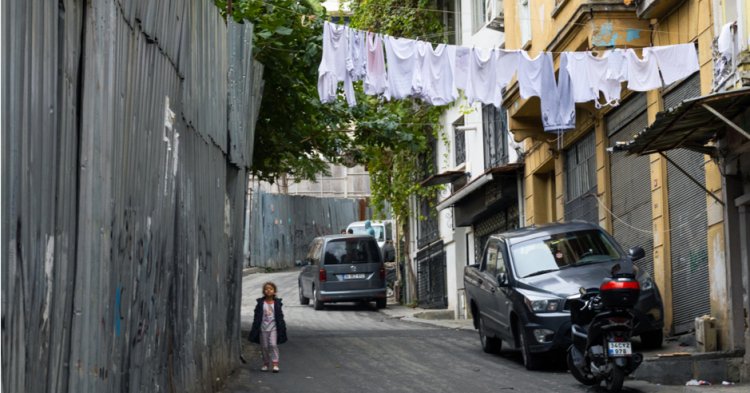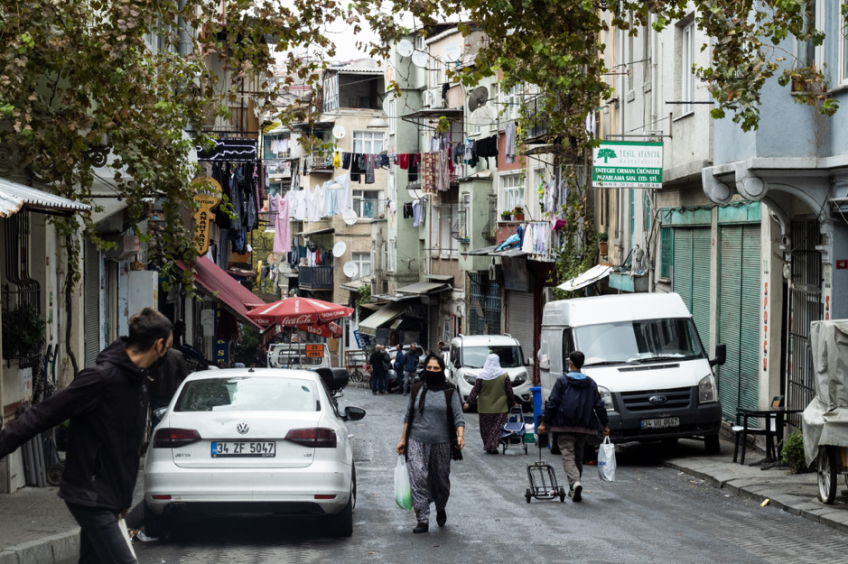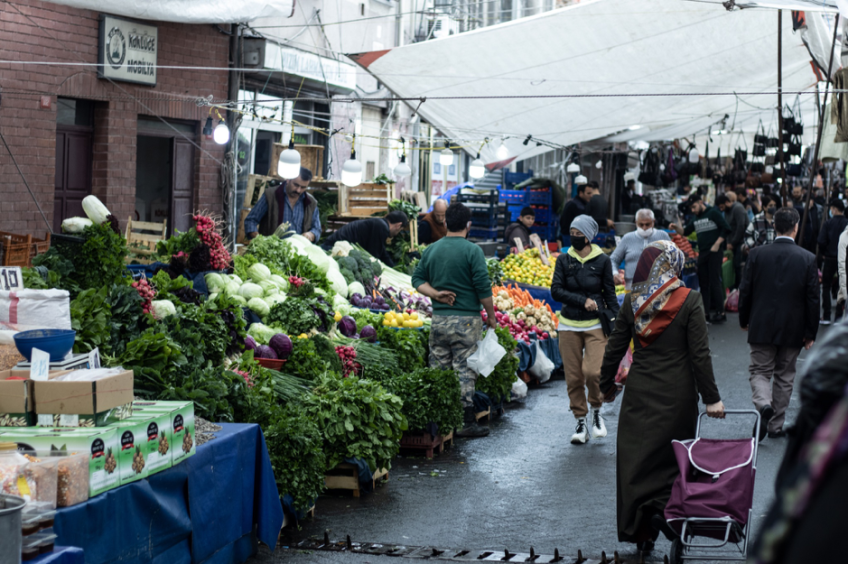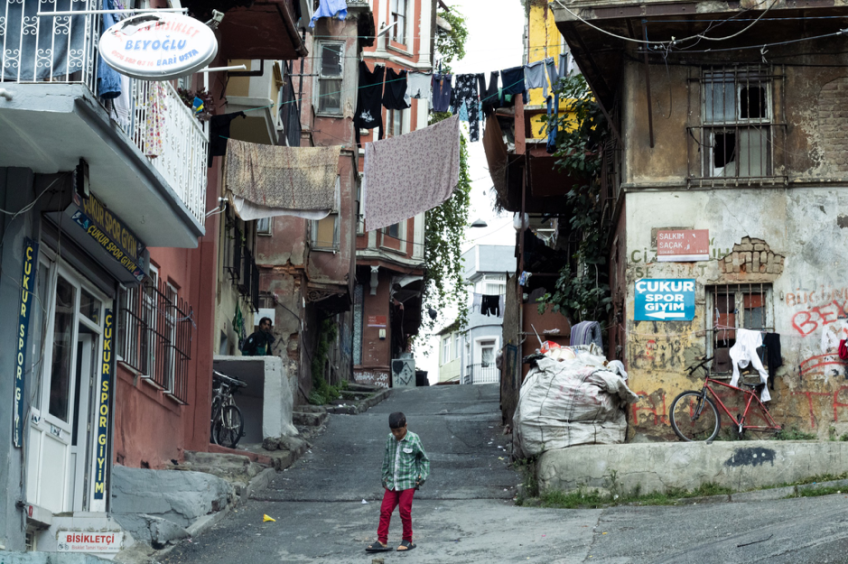In the words of May Hobbs, an activist who was deeply involved in the Women’s Liberation Movement in the 1970s and established the first trade union for cleaners, ‘one person’s slum is another person’s community.’ This phrase finds its reflection in the case study of Tarlabaşı, often referred to as Istanbul’s oldest ‘slum’. Considered by many to be a no-go area, Tarlabaşı has become home to thousands of new arrivals in Turkey who hoped for a better life but instead became victims of social exclusion.
Historically, Tarlabaşı was a place where minorities, such as Armenians, Jews, and Greeks, would find shelter after fleeing political instability and dire economic conditions. Since the 19th century, Tarlabaşı has been a residential area for the low-income class, predominantly inhabited by non-Muslim groups, in particular Greek Orthodox Christians and Sephardi Jews. To-day it is one of Istanbul’s most impoverished areas, a ghetto integrated into the urban land-scape of the city.
The contrast between Tarlabaşı and the neighbourhoods adjacent to it is striking. Tarlabaşı is just a few minutes away from Taksim square, the heart of Istanbul, and Istiklal Avenue boasting some of the city’s most luxurious restaurants and boutiques. But the atmosphere in Tarlabaşı does not remotely resemble the one of nearby buzzing spots that attract thousands of tourists each day.
Tarlabaşı feels lonely, isolated, and somewhat hostile as the communities who live there appear wearied of the marginalisation that other residents of the city condemn them to each day.
Tarlabaşı is hidden from view
Only one street separates Tarlabaşı from the cultural centre of the city, the Beyoglu district, home to museums and trendy art galleries. Looking over to the other side of the Tarlabaşı Boulevard, one can think that Tarlabaşı does not differ much from its neighbour. But, as the famous saying goes, first impressions can be deceiving.
Thanks to the gentrification project that the government introduced a few years ago, buildings on the edges of the neighbourhood have been renovated. And yet, behind the few modern buildings located right on the Tarlabaşı Boulevard, is a labyrinth of ageing, once-colourful but now washed out houses.
Streets of Tarlabaşı | Photo by Katarzyna Rybarczyk
The project was supposed to promote economic change and transform the landscape of Tarlabaşı but it seems like all it did is hide the run-down neighbourhood from view.
Transforming Tarlabaşı requires more than carrying out urban regeneration, especially if it concerns only a few buildings. It should first and foremost involve making sure that begging in nearby tourist areas or working in the exploitative informal sector are not the only options for the neighbourhood’s residents to make money. Although there are some social assistance programmes that those living in Tarlabaşı might be eligible for as low-income households, they remain severely under-funded.
Migrants come to Tarlabaşı in search of a better life
One thing that Tarlabaşı is known for is its diversity. Here, Turks, Arabs, Kurds, Afghans, and Africans coexist. As rent in Tarlabaşı is significantly lower than in other parts of Istanbul, the neighbourhood is often the first stop of new immigrants in Turkey. Many hope to spend some time there and after a while move to wealthier, more-developed districts or even to continue their journey into the European Union. However, with the harsh reality of refugees facing resentment and numerous obstacles preventing them from finding stable employment, Tarlabaşı is often not only the first stop but also their final destination.
Tarlabaşı has become home not only to migrants but also to the stigmatised transgender community. Both transgender identities and homosexuality are taboo subjects in widely conservative Turkey. For LGBTQ+ individuals Tarlabaşı is a safe haven where they do not have to hide who they are.
What brings all these communities together is the fact that they have been pushed to the margin of Istanbul’s society. The cultural differences sometimes turn out to be difficult to reconcile, however, and disagreements frequently take a violent turn. Besides, driven by poverty and desperate to put food on the table, many resort to crime. These people do not wish to be wrongdoers but as Pearl S. Buck once wrote ‘Hunger makes a thief of any man’.
Tarlabaşı has come to be associated with poverty and brutality
‘You shouldn’t go there alone, it’s dangerous’, a friend I made in Istanbul told me. I must admit that walking around the narrow streets of Tarlabaşı, navigating between piles of garbage and people asking for money, I did not see much happiness.
And yet, having gotten the chance to observe the daily life there, Tarlabaşı did not strike me as one of the toughest areas in Istanbul. Central to the neighbourhood is a market where Tarlabaşı’s residents sell fruits, vegetables, fish, and clothes.
Local market in Tarlabaşı | Photo by Katarzyna Rybarczyk
When I was walking around the market browsing various products I was under the impression that people were distrustful and slightly suspicious of me. After all, there are not many Westerners entering the area. Having said that, as soon as I would smile and show genuine interest in getting to know them, their attitude would change and I would receive a warm welcome.
The future of Tarlabaşı’s residents is uncertain
‘Do you like living in Tarlabaşı?’, I asked a man who sold me a hoodie at the local market. ‘No, it isn’t a good life here. I hope one day I will be able to leave’, he replied.
Even though many have settled down in Tarlabaşı, with limited employment opportunities, worsening living conditions, and increasing social alienation, they dream of being able to go somewhere else. Sadly, due to environmental constraints, the majority of them find themselves stuck there for years.
A child playing in the streets of Tarlabaşı | Photo by Katarzyna Rybarczyk
Tarlabaşı has become a place where migrants feel like they belong and that is a good thing as it gives them a sense of acceptance. However, the fundamental problem with this state of affairs is that Tarlabaşı is the only such setting in Istanbul. The moment the neighbourhood’s residents step out of Tarlabaşı, they have to deal with segregation and resentment.
It appears, therefore, that the image of Tarlabaşı as a safe space for migrants and disadvantaged communities is merely a façade, covering up the inequalities that persist in Turkey’s capital.




Follow the comments: |
|
